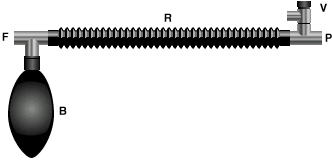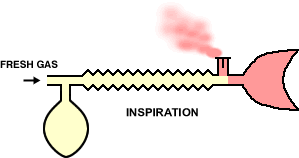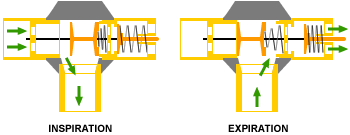 |
|||||||||||||||||||||
|
|
|
Magill Circuit The original Mapleson A system. Construction
A three-way T-tube is connected to the fresh gas outlet (F), a breathing bag (B) and a reservoir tube (R). The other end of the reservoir tube is connected to the patient (P) and a spring-loaded expiratory valve (V). Function
Inspiration
-The valve closes and the patient inspires fresh gas from the reservoir
tube. Controlled ventilation The problem
with attempting to perform intermittent positive pressure ventilation
with this circuit is that, when the bag is squeezed, the gas tends
to escape from the circuit via the expiratory valve rather than
inflating the lungs. This can be avoided by closing the expiratory
valve during each inspiration, although this is highly inconvenient.
It can be reduced by partially closing the expiratory valve, but
relatively high fresh gas flow rates must be employed to prevent
rebreathing.
On inspiration, or when the breathing bag is squeezed, the spring-loaded bobbin moves to close the expiratory limb, and on expiration it closes the inspiratory limb. When the valve is functioning correctly, the minute volume exactly equals the fresh gas flow rate. However, the bobbin can stick in the inspiratory position, particularly if the valve is wet or dirty, which directs the entire fresh gas flow into the lungs, which will rapidly lead to hyperinflation and pulmonary barotrauma. This may be avoided by adding a pressure-relief valve to the inspiratory limb, but this adds to the complexity of the arrangement. Generally, therefore, the Magill is not a suitable circuit for performing long term IPPV. Operational requirements
Advantages
Disadvantages
Uses
|
Comments on this
article should be addressed to Dr Guy
Watney
All pages © Anesthesia Service
and Equipment 1998-2003.


